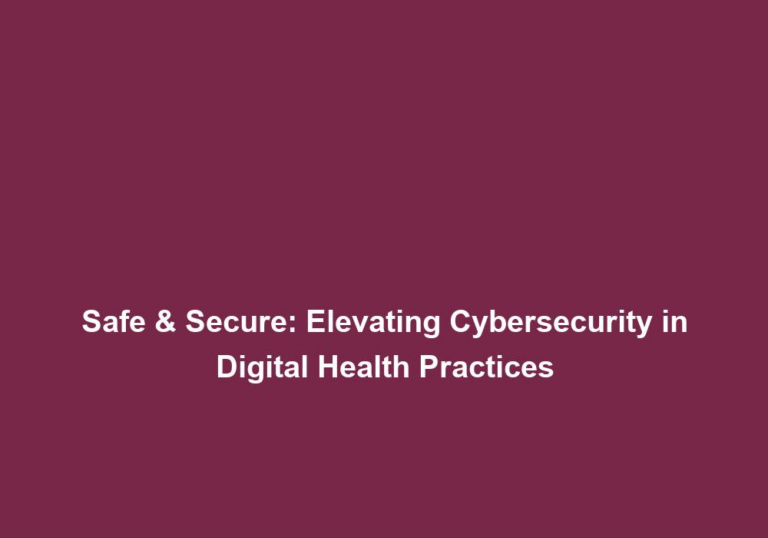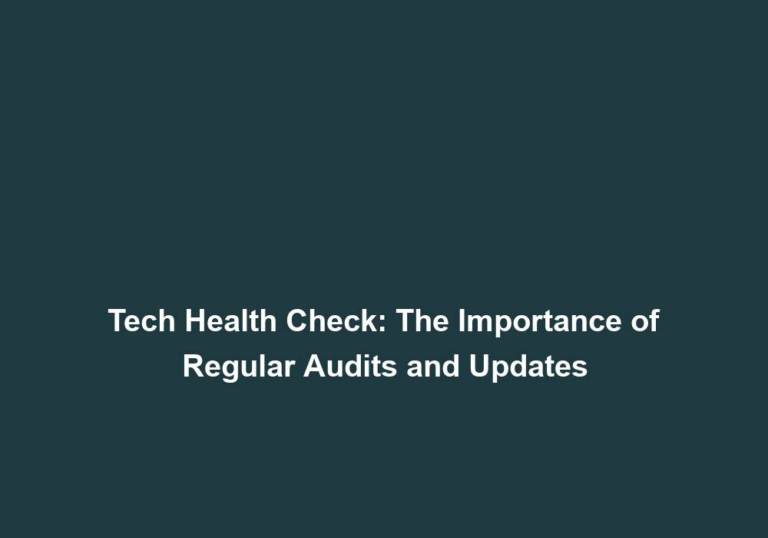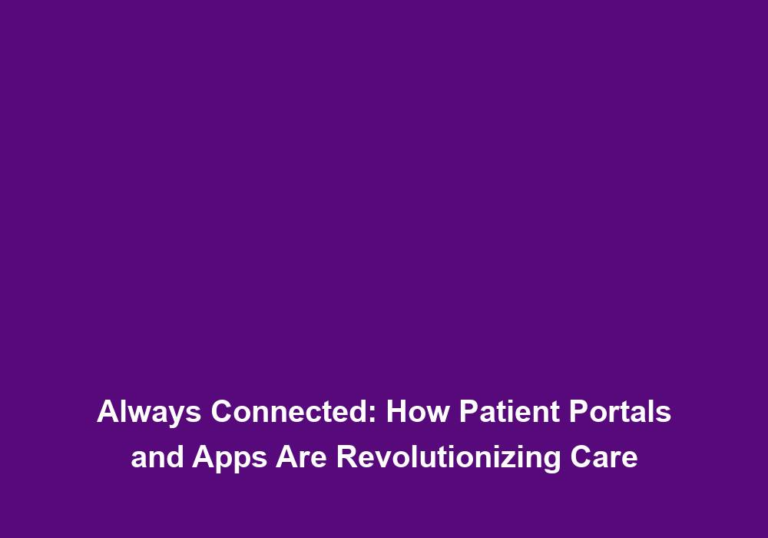Seamless Systems: Best Practices for Digital Tools Implementation in Healthcare
In recent years, the healthcare industry has witnessed a rapid transformation with the integration of digital tools and technologies. From electronic health records (EHR) to telemedicine platforms, these digital tools have revolutionized the way medical professionals provide care, manage patient data, and collaborate. However, the successful implementation of these tools requires careful planning, execution, and adherence to best practices. In this article, we will discuss the best practices for implementing digital tools in the healthcare sector to ensure a seamless and efficient system.
1. Conduct a Comprehensive Needs Assessment
Before implementing any digital tool, it is vital to conduct a comprehensive needs assessment to identify the specific requirements of your healthcare organization. This assessment should involve key stakeholders, including physicians, nurses, administrators, and IT personnel. By understanding the unique needs and challenges of your organization, you can select digital tools that align with your goals and objectives.
To conduct a comprehensive needs assessment, consider the following steps:
- Gather input from various stakeholders: Engage with physicians, nurses, administrators, and IT personnel to understand their pain points and requirements. Each group may have different needs, so it is important to consider all perspectives.
- Analyze existing workflows: Evaluate the current processes and workflows within your organization. Identify bottlenecks, inefficiencies, and areas for improvement.
- Identify specific goals and objectives: Determine what you want to achieve with the implementation of digital tools. Whether it is improving patient outcomes, streamlining data management, or enhancing collaboration, clearly define your objectives.
- Research available digital tools: Explore the market for digital tools that address your organization’s specific needs. Consider factors such as functionality, scalability, compatibility, and cost.
- Evaluate potential benefits and risks: Assess the potential benefits and risks associated with each digital tool. Consider factors such as ease of implementation, user adoption, data security, and regulatory compliance.
By conducting a comprehensive needs assessment, you can make informed decisions about which digital tools to implement and ensure that they align with your organization’s goals and objectives.
2. Evaluate the User Interface and User Experience
A crucial aspect of successful digital tool implementation is the user interface (UI) and user experience (UX). The UI should be intuitive, visually appealing, and user-friendly to ensure easy adoption by healthcare professionals. The UX should prioritize the needs of end-users, reducing their cognitive load and facilitating efficient workflows. Conducting usability testing and obtaining feedback from potential users can help in refining the UI and UX of the digital tools.
To evaluate the UI and UX of digital tools, consider the following:
- Conduct usability testing: Engage healthcare professionals who will be using the digital tools in testing and provide them with scenarios to navigate through the interface. Observe their interactions and gather feedback on the usability, intuitiveness, and overall experience.
- Gather user feedback: Encourage healthcare professionals to provide feedback on their experience with the digital tools. Ask for suggestions on improving the UI and UX to better meet their needs.
- Incorporate user-centered design principles: Design the UI and UX with a user-centered approach, considering the specific requirements and workflows of healthcare professionals. Simplify complex processes, minimize the number of clicks, and provide clear instructions and visual cues.
- Ensure responsiveness: With the increasing use of mobile devices in healthcare settings, it is important to ensure that the digital tools have a responsive design that adapts to different screen sizes and resolutions. This allows healthcare professionals to access the tools conveniently from their mobile devices.
By prioritizing the UI and UX of digital tools, healthcare organizations can enhance user adoption, improve efficiency, and facilitate seamless workflows.
3. Ensure Interoperability and Integration
To achieve seamless systems in healthcare, it is essential to ensure interoperability and integration among different digital tools. Healthcare organizations often use multiple systems, such as EHRs, laboratory information management systems (LIMS), and picture archiving and communication systems (PACS). Integrating these systems allows for the seamless exchange of data between different platforms, reducing duplicate data entry and enhancing efficiency.
To ensure interoperability and integration, consider the following:
- Adopt industry standards: Utilize standard protocols and formats, such as Health Level Seven (HL7) and Fast Healthcare Interoperability Resources (FHIR), to facilitate data exchange and interoperability between different systems.
- Implement integration middleware: Use integration middleware solutions to connect and synchronize data between different digital tools. This enables real-time data sharing and avoids data silos.
- Establish data governance policies: Develop policies and procedures to govern the exchange, storage, and use of data across different systems. Ensure that data integrity, confidentiality, and security are maintained throughout the integration process.
- Collaborate with vendors: Engage with vendors of digital tools to ensure that their systems are compatible with existing infrastructure and can seamlessly integrate with other systems. Request information on their interoperability capabilities and integration options.
By ensuring interoperability and integration, healthcare organizations can achieve a unified and efficient system where data flows seamlessly between different digital tools, enabling better decision-making and improving patient care.
4. Prioritize Data Security and Privacy
When implementing digital tools in healthcare, data security and privacy must be paramount. Patient health information is highly sensitive and must be protected from unauthorized access or breaches. It is essential to comply with relevant privacy regulations, such as the Health Insurance Portability and Accountability Act (HIPAA) in the United States. Implementing robust security measures, such as encryption, access controls, and regular data backups, can safeguard patient information.
To prioritize data security and privacy, consider the following:
- Conduct a risk assessment: Identify potential risks and vulnerabilities in the storage, transmission, and processing of patient data. Assess the likelihood and impact of security breaches and develop strategies to mitigate these risks.
- Implement strong authentication mechanisms: Utilize multi-factor authentication to ensure that only authorized individuals can access patient data. This may include the use of passwords, biometrics, or smart cards.
- Encrypt sensitive data: Employ encryption techniques to protect patient data while it is stored, transmitted, or shared. Encryption ensures that even if the data is intercepted, it remains unreadable without the decryption key.
- Regularly update and patch systems: Keep all digital tools and systems up to date with the latest security patches and updates. Regularly monitor for vulnerabilities and address them promptly.
- Train staff on security protocols: Provide comprehensive training to healthcare professionals and staff on data security best practices. Educate them about the importance of data privacy, the risks associated with data breaches, and the proper handling of patient information.
By prioritizing data security and privacy, healthcare organizations can instill trust among patients, protect sensitive information, and comply with regulatory requirements.
5. Provide Adequate Training and Support
Successful implementation of digital tools requires healthcare professionals to be proficient in their use. Providing adequate training and support is crucial to ensure proper adoption and utilization of the tools. Training programs should be tailored to the needs of different user groups, considering their roles and responsibilities. Ongoing technical support should also be available to address any issues or concerns raised by the users.
To provide adequate training and support, consider the following:
- Develop comprehensive training materials: Create user manuals, video tutorials, and interactive online courses to guide healthcare professionals in effectively using the digital tools. Ensure that the training materials are easily accessible and available in different formats.
- Conduct training sessions: Organize training sessions where healthcare professionals can receive hands-on experience with the digital tools. Provide opportunities for interactive learning, demonstrations, and Q&A sessions.
- Offer ongoing technical support: Establish a dedicated support team that can promptly address any technical issues or queries raised by healthcare professionals. Provide multiple channels of communication, such as email, phone, and live chat, to ensure accessibility.
- Monitor user adoption and engagement: Regularly assess the effectiveness of the training programs and support services. Seek feedback from healthcare professionals and make necessary improvements based on their suggestions.
By providing adequate training and support, healthcare organizations can empower their workforce to effectively utilize digital tools, maximize their benefits, and deliver high-quality care to patients.
6. Regularly Evaluate and Improve
Digital tools and technologies in healthcare are continually evolving, and it is essential to stay updated with the latest advancements. Regularly evaluating the effectiveness and efficiency of implemented systems can help identify areas for improvement. Seeking feedback from end-users and incorporating their suggestions can enhance the overall experience and optimize workflows.
To regularly evaluate and improve digital tools implementation, consider the following:
- Establish performance metrics: Define key performance indicators (KPIs) to measure the success of the implemented systems. This may include metrics such as user satisfaction, productivity gains, reduction in errors, or improved patient outcomes.
- Conduct user surveys and feedback sessions: Routinely gather feedback from healthcare professionals about their experience with the digital tools. Ask for suggestions on how to enhance usability, functionality, and overall system performance.
- Stay informed about industry trends: Keep abreast of the latest developments and trends in digital tools and healthcare technologies. Attend conferences, webinars, and workshops to learn from industry experts and gain insights into emerging best practices.
- Engage in continuous improvement initiatives: Based on user feedback and industry trends, develop improvement plans to address any identified shortcomings or areas for enhancement. Implement these improvements iteratively, ensuring minimal disruption to ongoing operations.
By regularly evaluating and improving digital tools implementation, healthcare organizations can stay ahead of the curve, optimize workflows, and deliver better patient outcomes.
Conclusion
Implementing digital tools in healthcare can significantly improve the efficiency, accuracy, and accessibility of patient care. However, the success of implementation relies on following best practices and considering the unique needs of your healthcare organization. By conducting a comprehensive needs assessment, prioritizing UI/UX, ensuring interoperability, maintaining data security, providing training and support, and regularly evaluating and improving, healthcare organizations can achieve seamless systems that enhance patient outcomes and streamline workflows.






